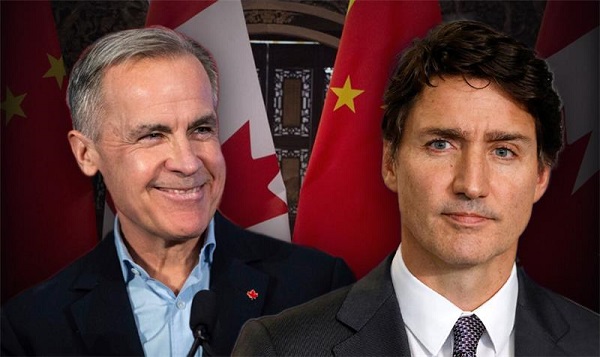Business
Who owns Canada’s public debt?


 David Clinton
David Clinton
Remember when thinking about our debt crisis was just scary?
During his recent election campaign, Mark Carney announced plans to add $225 billion (with a “b”) to federal debt over the next four years. That, to put it mildly, is a consequential number. I thought it would be useful to put it into context, both in terms of our existing debt, and of some social and political changes those plans could spark.
How much money does Canada currently owe? According to Statistics Canada’s statement of government operations and balance sheet, as of Q4 2024, that number would be nearly $954 billion. That’s compared with the $621 billion we owed back in 2015.
The Audit is a reader-supported publication.
To receive new posts and support my work, consider becoming a free or paid subscriber.
How much does interest on our current debt cost us each year? The official Budget 2024 document predicted that we’d pay around $51 billion each year to just service our debt. But that’s before piling on the new $225 billion.
We – and the governments we elect – might be tempted to imagine that the cash behind public loans just magically appears out of thin air. In fact, most Canadian government debt is financed through debt securities such as marketable bonds, treasury bills, and foreign currency debt instruments. And those bonds and bills are owned by buyers.
Who are those buyers? Many of them are probably Canadian banks and other financial institutions. But as of February 2025, according to Statistics Canada, it was international portfolio investors who owned $527 billion of Canadian federal government debt securities.
Most of those foreign investors are probably from (relatively) friendly countries like the U.S. and U.K. But that’s certainly not the whole story. Although I couldn’t find direct data breaking down the details, there are some broadly related investment income numbers that might be helpful.
Specifically, all foreign investments into both public and private entities in Canada in 2024 amounted to $219 billion dollars. In that same year, investments from “all other countries” totaled $51 billion. What Statistics Canada means by “all other countries” covers all countries besides the US, UK, EU, Japan, and the 38 OECD nations.
The elephant in the “all other countries” room has to be China.
So let’s break this down. The $527 billion foreign-owned investment debt I mentioned earlier represents around 55 percent of our total debt.¹ And if the “all other countries” ratio in general foreign investments holds true² for federal public debt, then it’s realistic to assume that the federal government currently owes around 11 percent of its debt to government and business entities associated with the Chinese Communist Party.
By all accounts, an 11 percent share in a government’s debt counts as leverage. Given China’s recent history, our ability to act independently in international and even domestic affairs could be compromised. But it could also be destabilizing, exposing us to risk if China’s economy faces turmoil which could disrupt our ability to roll over debt or secure new financing.
Mark Carney’s plan to add another 20 percent to our debt over the next four years will only increase our exposure to these – and many more – risks. Canadian voters have made an interesting choice.
“Democracy is the theory that the common people know what they want, and deserve to get it good and hard.” – H.L. Mencken
The Audit is a reader-supported publication.
To receive new posts and support my work, consider becoming a free or paid subscriber.
Business
RFK Jr. planning new restrictions on drug advertising: report

Quick Hit:
The Trump administration is reportedly weighing new restrictions on pharmaceutical ads—an effort long backed by Health Secretary Robert F. Kennedy Jr. Proposals include stricter disclosure rules and ending tax breaks.
Key Details:
-
Two key proposals under review: requiring longer side-effect disclosures in TV ads and removing pharma’s tax deduction for ad spending.
-
In 2024, drug companies spent $10.8 billion on direct-to-consumer ads, with AbbVie and Pfizer among the top spenders.
-
RFK Jr. and HHS officials say the goal is to restore “rigorous oversight” over drug promotions, though no final decision has been made.
Diving Deeper:
According to a Bloomberg report, the Trump administration is advancing plans to rein in direct-to-consumer pharmaceutical advertising—a practice legal only in the U.S. and New Zealand. Rather than banning the ads outright, which could lead to lawsuits, officials are eyeing legal and financial hurdles to limit their spread. These include mandating extended disclosures of side effects and ending tax deductions for ad spending—two measures that could severely limit ad volume, especially on TV.
Health and Human Services Secretary Robert F. Kennedy Jr., who has long called for tougher restrictions on drug marketing, is closely aligned with the effort. “We are exploring ways to restore more rigorous oversight and improve the quality of information presented to American consumers,” said HHS spokesman Andrew Nixon in a written statement. Kennedy himself told Sen. Josh Hawley in May that an announcement on tax policy changes could come “within the next few weeks.”
The ad market at stake is enormous. Drugmakers spent $10.8 billion last year promoting treatments directly to consumers, per data from MediaRadar. AbbVie led the pack, shelling out $2 billion—largely to market its anti-inflammatory drugs Skyrizi and Rinvoq, which alone earned the company over $5 billion in Q1 of 2025.
AbbVie’s chief commercial officer Jeff Stewart admitted during a May conference that new restrictions could force the company to “pivot,” possibly by shifting marketing toward disease awareness campaigns or digital platforms.
Pharma’s deep roots in broadcast advertising—making up 59% of its ad spend in 2024—suggest the impact could be dramatic. That shift would mark a reversal of policy changes made in 1997, when the FDA relaxed requirements for side-effect disclosures, opening the floodgates for modern TV drug commercials.
Supporters of stricter oversight argue that U.S. drug consumption is inflated because of these ads, while critics warn of economic consequences. Jim Potter of the Coalition for Healthcare Communication noted that reinstating tougher ad rules could make broadcast placements “impractical.” Harvard professor Meredith Rosenthal agreed, adding that while ads sometimes encourage patients to seek care, they can also push costly brand-name drugs over generics.
Beyond disclosure rules, the administration is considering changes to the tax code—specifically eliminating the industry’s ability to write off advertising as a business expense. This idea was floated during talks over Trump’s original tax reform but was ultimately dropped from the final bill.
Business
Canada’s critical minerals are key to negotiating with Trump

From Resource Works
The United States wants to break its reliance on China for minerals, giving Canada a distinct advantage.
Trade issues were top of mind when United States President Donald Trump landed in Kananaskis, Alberta, for the G7 Summit. As he was met by Prime Minister Mark Carney, Canada’s vast supply of critical minerals loomed large over a potential trade deal between North America’s two largest countries.
Although Trump’s appearance at the G7 Summit was cut short by the outbreak of open hostilities between Iran and Israel, the occasion still marked a turning point in commercial and economic relations between Canada and the U.S. Whether they worsen or improve remains to be seen, but given Trump’s strategy of breaking American dependence on China for critical minerals, Canada is in a favourable position.
Despite the president’s early exit, he and Prime Minister Carney signed an accord that pledged to strike a Canada-US trade deal within 30 days.
Canada’s minerals are a natural advantage during trade talks due to the rise in worldwide demand for them. Without the minerals that Canada can produce and export, it is impossible to power modern industries like defence, renewable energy, and electric vehicles (EV).
Nickel, gallium, germanium, cobalt, graphite, and tungsten can all be found in Canada, and the U.S. will need them to maintain its leadership in the fields of technology and economics.
The fallout from Trump’s tough talk on tariff policy and his musings about annexing Canada have only increased the importance of mineral security. The president’s plan extends beyond the economy and is vital for his strategy of protecting American geopolitical interests.
Currently, the U.S. remains dependent on China for rare earth minerals, and this is a major handicap due to their rivalry with Beijing. Canada has been named as a key partner and ally in addressing that strategic gap.
Canada currently holds 34 critical minerals, offering a crucial potential advantage to the U.S. and a strategic alternative to the near-monopoly currently held by the Chinese. The Ring of Fire, a vast region of northern Ontario, is a treasure trove of critical minerals and has long been discussed as a future powerhouse of Canadian mining.
Ontario’s provincial government is spearheading the region’s development and is moving fast with legislation intended to speed up and streamline that process. In Ottawa, there is agreement between the Liberal government and Conservative opposition that the Ring of Fire needs to be developed to bolster the Canadian economy and national trade strategies.
Whether Canada comes away from the negotiations with the US in a stronger or weaker place will depend on the federal government’s willingness to make hard choices. One of those will be ramping up development, which can just as easily excite local communities as it can upset them.
One of the great drags on the Canadian economy over the past decade has been the inability to finish projects in a timely manner, especially in the natural resource sector. There was no good reason for the Trans Mountain pipeline expansion to take over a decade to complete, and for new mines to still take nearly twice that amount of time to be completed.
Canada is already an energy powerhouse and can very easily turn itself into a superpower in that sector. With that should come the ambition to unlock our mineral potential to complement that. Whether it be energy, water, uranium, or minerals, Canada has everything it needs to become the democratic world’s supplier of choice in the modern economy.
Given that world trade is in flux and its future is uncertain, it is better for Canada to enter that future from a place of strength, not weakness. There is no other choice.
-

 Business2 days ago
Business2 days agoThe CBC is a government-funded giant no one watches
-

 conflict2 days ago
conflict2 days agoMiddle East clash sends oil prices soaring
-

 Business2 days ago
Business2 days agoTrump makes impact on G7 before he makes his exit
-

 Also Interesting2 days ago
Also Interesting2 days agoHow to Use Bonuses at Magius Casino and Similar Websites
-

 Alberta2 days ago
Alberta2 days agoAlberta is investing up to $50 million into new technologies to help reduce oil sands mine water
-

 conflict2 days ago
conflict2 days agoTrump Threatens Strike on Khamenei as Israel Pounds Iranian Military Command
-

 International2 days ago
International2 days agoTrump not seeking ceasefire with Israel, Iran as he rushes back to White House
-

 conflict2 days ago
conflict2 days agoTrump: ‘We’ have control over Iranian airspace; know where Khomeini is hiding






